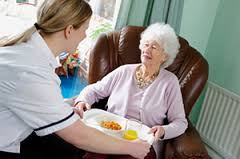As part of your home health management planning include disaster preparedness to satisfy JCAHO, CHAP and ACHC compliance.
In the event of a flood, fire, hurricane, tornado, blizzard, wind storm, and any other disaster that affects the delivery of scheduled home health care services, your agency should have the following emergency  preparedness plan to maintain uninterrupted communication between Agency decision makers and caregivers, and uninterrupted home care services to priority patients...
preparedness plan to maintain uninterrupted communication between Agency decision makers and caregivers, and uninterrupted home care services to priority patients...
1. Maintain a toll-free telephone hotline.
Staff and patients will benefit from a telephone hotline to get updates on delivery of home health services during a flood, fire, hurricane, tornado, blizzard, wind storm, and any other disaster. This hotline should be a recorded message that advises staff on whether they should perform assignments as scheduled, or stay home. The message should alert emergency staff of the number they can call to communicate with Patient Care Management and get assignments of high-priority patients. This toll-free hotline should be maintained 24 hours per day, 7 days per week. Any time a staff member has a question about the status of an assignment because of inclement weather - or any other reason - s/he will call the hotline.
2. Document contingency plan for each and every patient.
When the Case Manager admits a patient, s/he should document the patient’s contingency plan on the Assessment Form, and on the Hours of Operation and Emergencies form to be filed in the patient’s home chart. In order to be admitted to the Agency, the patient should have a reliable neighbor, family member, or community member that can make sure the patient is safe in the event of a disaster.
3. Start discharge planning on the first visit.
Discharge planning should start at the admission visit. Accordingly, the patient/family should be prepared for independence and discharge right at the very beginning of care including prompt preparation of the patient/family for independence in self-care for circumstances such as the occurrence of a natural disaster.
4. Maintain a High-Priority Patient Form.
The Care Manager should maintain a High-Priority Patient Form on a weekly basis. This form should list all of the Agency’s patients/family members that are unable to manage critical treatments - such as insulin administration or parenteral nutrition therapy. The Care Manager should also be required to notify the patient’s local police and fire station of any patient/family who is dependent on critical treatments. In the event of a disaster in which emergency caregivers can be mobilized, high-priority patients will be visited by their own emergency caregivers. In the event of a disaster that prevents even emergency caregivers from being mobilized, the Agency will alert the police or fire station to mobilize emergency transportation to move the patient from the home to a hospital.
5. Maintain a list of Emergency Caregivers.
The Scheduling Coordinator should maintain a list of staff that have elected to be available for emergency assignments in the event of a disaster. These emergency staff should carry beepers that are on at all times, and cellular phones that are to be activated when the beeper sounds. Emergency staff are selected based on home location and reliability of their transportation so that they can travel safely to high priority patients that are in close proximity. In the event of an emergency, the Care Manager should contact all scheduled patients and contingency plans to advise them when to (1) activate the contingency plan, (2) expect an emergency caregiver to be performing the visit, or (3) expect emergency transportation from the local police or fire department to be activated to get the patient to a facility.
6. Maintain a list of patients with equipment that requires electricity.
Equipment management should maintain documentation of the working condition of back-up power supplies such as batteries and/or generators for patient equipment that requires electricity including back-up oxygen, self-inflating resuscitation bags, spare breathing circuits, and ambu-bags.




